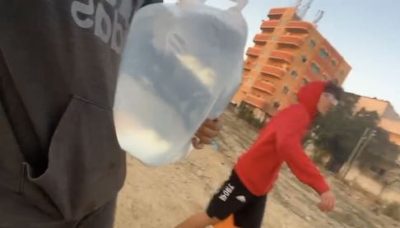
A reckoning is due for Great British Energy – the UK government’s nascent £8.3b industry accelerator. Announced as the centrepiece of the UK “growth mission” its launch was accompanied by the news that it had spent £640m buying the nerve centre of the National Grid – the control room that apportions energy across the country on a live daily basis. In 2035 we may look back on that deal and think “only £640m…” British energy Minister Ed Miliband has firm plans to waste billions by then – on carbon capture and Contracts for Difference, as well as reparations to low-lying islands in the Pacific, and thousands of hotel nights spent attending Cops30-40.
Literally anything could happen to the UK energy supply this winter, and almost all of it is bad.
But there is also something we can all do in our individual communities – to prepare for possible power cuts, this winter or any other winter.
After all, every household in the UK spends an average of £1700 a year on energy.
Ed’s big problem is that he has raised expectations. He announced that not only will he solve the nation’s energy conundrum, but that he will also save money while doing it, keep the lights on, build 1.5m new home and launch a new global Britain on the back of it.
The energy industry, and the entire country, is waiting for action. But Britain can never be an energy super-power, and Ed must know this.
Consider the facts – Annual GB electricity consumption is 292.7 terawatt-hours (TWh) of electricity in 2023, about the same as Texas, a vast state with multiple connectivity issues in outlying areas. The UK has a small, compact grid, which is currently undergoing major re-engineering for decarbonisation.
Electricity demand is forecast to grow at 5% a year, but generation is not increasing at the same pace until 2029. The maximum power to be provided by two new nuclear plants planned (if they are on time it would be a first) is 56TWh. And Ed wants sharp reductions in oil and gas for electricity production. That produces a shortfall of another 50TWh by 2029
Then there is a 10-yr waiting list for new housing estates to get on the grid. That’s right – ten years from time of application to secure a supply from the grid. Yet Labour says it will build at least a million homes in the next 4 years. How will it power the new homes? There is also a 10-yr waiting list for new solar farms to go on the grid, due to structural problems that require hundreds of miles of new cabling and pylons. Quite simply, the grid is not fit for purpose, and nor is there the slightest chance it will be re-engineered until well after 2030. Nevertheless, the government says it wants to decarbonise the electricity system by 2030.…

Whatever your views on the Arab-Israel conflicts, and on the Hamas atrocities of October 9th, nobody can no doubt that the humanitarian crisis demands immediate action by all of us – especially now that UNWRA has been exposed as a deeply suspect organisation. Sending money to huge bureaucracies like Save the Children or UNWRA – you know for sure that much of it goes in admin, bribes and other priorities than your own.
So if you want to help Palestinians on the ground in Gaza, who are surviving on tiny morsels of food, limited water and intermittent energy, if you want all your money to go straight to those in need – then we have a way.
Our cameraman in Gaza, will spend what we send him on buying solar panels, and film himself donating them to ordinary families. He has already been donating cash this way – brought in via Egypt.
He shot our latest Youtube footage, showing him distributing donated money – 50 shekels at a time. You can see the ID cards of the women as he hands them the money. You can see they are innocent citizens and not terrorists. Watch the video on our socials, and tell your friends.
Insta
https://www.instagram.com/reel/C3SFn31IQld/?igsh=a3Nxa3R4YjFnNDZo
Facebook
https://fb.watch/qaYFhPNFqc/
Tiktok
Banned
Youtube shorts
But solar panels are more valuable than money – they are the gift that keeps on giving. We have found a supply of panels in Gaza, and any donations received will be used to purchase them and give them to communities in need of energy to power their lights and phones.
Please paypal to nick@off-grid.net and we will get the money straight out there the next day.
Mark your paypal: Solar Panels for Palestine.…

The tragic war in Gaza has left hundreds of thousands off the grid – with no water or power and very little food.
Off-grid has obtained exclusive footage from the streets of Southern Gaza – available to watch on our youtube channel – offgridnet .
It is quite dangerous to gather this footage and our thanks go to our long-standing cameraman in the region. We are not naming him for security purposes.
After they queue for hours at aid stations for tiny amounts of sustenance, and to recharge their phones – Gaza residents then return to bombed-out shelters to cook morsels of bread on campfires and go to the toilet in whatever unused corners they can find.
They search the trash for materials for their fires to cook by. Off-Grid.net is trying to send solar panels and batteries to Gaza but there are many obstacles.
The Israeli army prevents batteries and solar panels from getting through, claiming the equipment has a military purpose. But this claim ignores the humanitarian emergency unfolding, and makes Israel’s IDF look as though they are deliberately imposing siege conditions on the Gaza population.
Hospitals are another place where Gazans can charge their phones and pick up water.
Please contact us if you want to help us provide off-grid aid to Gaza – contact
Please contact us with footage from off-grid zones, anywhere in the world.…

A MAN who gave up his normal life to live off the grid with his family has revealed how – and why – he did it.
Fraser, his wife Rachael and their children Grace and Albie stay in a patch of woodlands in Lancashire, UK. But the 4.5 acres of land was bare when Fraser managed to pull £15,500 together to buy it 18 years ago.
Fraser said: “Holding out for that perfect piece of land isn’t always feasible because there’s always someone there with a larger wallet than you – get something you can afford.
“Plant trees as quickly as you can, because it’s going to take a long time, then make it your paradise.”
He’s now living the dream after building a completely off-the-grid life for him and his young family. The dad-of-two says he was just 22 and living at home in council housing when he scraped the money together – and hasn’t looked back since.
He’s left behind the noisy neighbours and ended up running his own YouTube channel named The Off Grid Family, encouraging others to take the leap, too.
Recalling almost 20 years ago, Fraser said: “I was living at home, living on a council housing estate. The area was a bit rough, and you’ve got noisy neighbours and all those things that come with it.”
He said house prices were through the roof – even for back then – so he started up a business in tree surgery to try get some funds together.
Fraser continued: “My passion was growing trees and having nature around me. You couldn’t get a mortgage for land. I had to get a personal loan. The land was £15,500 for 4.5 acres – it was an awful lot of money for me.
“The only way I managed to do it really was because I was still living at home. There was no inheritance and there was no trust fund.
“People think you can’t get this without help… you can. I went to work and in the beginning was working six days a week.”
At the beginning he just planted trees on the land and used it as storage – which is called “agroforestry”.
He’s since planted thousands of trees, a massive bar, solar and water filtration system.
Fraser said: “It’s been a massive undertaking. We’re completely off the grid. We’ve got a family now living here and I suppose it’s called the good life. They’re quite fortunate really, we’ve broken the cycle, they’re not going to be on a housing estate, which is brilliant.”…

 Embarking on an off-grid journey? Buckle up, because the location you choose might just be the pivot between thriving and barely surviving in your sustainable haven. Finding the right spot isn’t just a choice; it’s a masterstroke in the canvas of off-grid living.
Embarking on an off-grid journey? Buckle up, because the location you choose might just be the pivot between thriving and barely surviving in your sustainable haven. Finding the right spot isn’t just a choice; it’s a masterstroke in the canvas of off-grid living.
Picture this: basking in the sun, harvesting energy from the abundant rays. Or, snug inside during chilly winters, relying on stored resources. Climate isn’t just small talk; it’s the cornerstone of your off-grid venture. The sun worshippers would revel in solar power in sun-drenched areas, while wind aficionados might thrive in breezier locales. Always assess how the climate aligns with your energy goals and lifestyle.
You’re the captain of your self-sufficient ship, and resources are your treasure trove. Water sources – abundant or scarce? Forests – foraging heaven or firewood woes? Land fertility – a potential garden paradise or a barren challenge? Unravel the resources your location offers, ensuring they align with your self-sustaining dreams.
Ah, the legal tangle – a less romantic yet vital aspect. Zoning laws, building permits, and property regulations can either smoothen your off-grid sail or tangle it in red tape. Research local laws diligently; they could either support your vision or pose unexpected hurdles.
Off-grid living often means being off the beaten path. But how off is too off? Accessibility matters – for supplies, emergencies, and even the human need for connection. Balancing remoteness with access to essentials is a delicate art.
Are you a lone wolf or a tribe seeker? The presence of like-minded individuals in the vicinity can make a world of difference. Sharing knowledge, resources, and occasional bonfires might be just what the off-grid doctor ordered.
In the symphony of off-grid living, the location holds the conductor’s baton, dictating the harmony or discord of your sustainable lifestyle. It’s not just about a spot on the map; it’s about aligning the environment with your off-grid aspirations.
So, aspiring off-gridders, heed this call: evaluate, scrutinize, and choose your off-grid Eden wisely. The right location isn’t just a pin on a map; it’s the cornerstone of your self-sustaining utopia.
Choose. Prepare. Thrive. Welcome to the symphony of off-grid living!…

ALL over the world, governments are handing farmers green subsidies in the form of carbon credits for certain types of planting and land management that sequester or reduce carbon consumption. But small growers, including off-gridders and allotment owners, are excluded from this cosy arrangement. The grants total tens of billions each year according to McKinsey, a consulting firm.
If you are a smallholder who wants to apply for your carbon credits, get in touch with us at off-grid.net, or leave a comment at the end of this story. We will collate all claims and submit them when there are enough to qualify.
In Britain, for example, farmers have two options – go green or go under. The calculation is simple – A farmer plants a wood, grows bigger hedgerows or tends the soil in a certain way, that sucks a certain number of tonnes of carbon dioxide out of the atmosphere.
This is verified and the farm is then granted a certificate for how much CO2 it has absorbed, which can be sold to a business that needs to reduce its own carbon footprint.
The UK is not alone in this field, with similar initiatives under way in the US, the EU, Australia and New Zealand.
In eastern Australia, a vast area called the “mulga belt” is now home to a booming carbon trading industry that has netted 150 businesses at least $300m in less than a decade, according to official figures reported by the Washington Post.
Businesses should be looking to reduce their own emissions first, say experts, but carbon credits could help with any residual emissions, the ones that are difficult or impossible to remove.
Farms and landowners are well placed to help with this, as many actions they can take to improve their own operations will also cut carbon emissions.
Farmers can apply for carbon credits if they plant their fields with environmentally-approved crops. Small growers cannot. The amount seems small, only a £100 per Hectare in the UK and £168 for woodland, but to someone with a two Hectare smallholding who survives perfectly well on £10,000 a year, its a 2% pay rise, for doing what they were going to do anyway.
At the moment, UK farmers cannot participate in the British emissions trading scheme, although this may change soon with the Government having recently consulted on proposals to bring them in. But there is nothing to stop us all, every landowner, garden owner and allotment owner who wants to log-in to any online application form set up for farmers.
In the meantime, farms and others can participate in voluntary carbon trading markets. The two most established are the Woodland Carbon Code and the Peatland Code, both of which are recorded on the UK Land Carbon Registry.
The woodland code rewards landowners for planting trees, typically over a typical period of 30 to 40 years. It …

Yes, you can use the material from a composting toilet to fertilize your plants and it has an honourable tradition. In eighteenth century Japan, human excrement played a vital role in agriculture. Can similar solutions help manage waste today? Because every drop of waste was gathered and used, Japanese cities did not have a problem with overflowing latrines, stinky street gutters, and other sanitation issues which plagued urban Europe at the time.
You must ensure the material is fully composted before it can be used as fertilizer. It should be allowed to decompose for sufficient time, usually several months, and should reach high enough temperatures to kill any pathogens. Ensure that the compost is well-aerated and turned regularly to speed up the decomposition process. Once the compost is fully decomposed, it can be added to your garden as a fertilizer.
There are several additives that can be added to compost to increase the speed of decomposition:
NB: a balance of green (nitrogen-rich) and brown (carbon-rich) materials in your compost pile is crucial for optimal decomposition and to avoid unpleasant odors.
It is generally not recommended to use human waste directly on fruit trees or other food crops due to the risk of contamination with harmful pathogens, but as long as you are doing this on your own land with your own waste, it is very low risk. Health & Safety guidance suggests human waste can be treated, either through a septic system or a composting toilet, to kill off any harmful bacteria before it is used as a fertilizer. However, it may be illegal to use human waste as a fertilizer in some areas, so you should check local laws before doing so.…

 I appreciate today’s short attention span theater, I have a lot to say about kefir. If you want the short version, scroll down, you’ll see it. ?
I appreciate today’s short attention span theater, I have a lot to say about kefir. If you want the short version, scroll down, you’ll see it. ?
We have known for many generations about the health benefits of consuming probiotics. Fortunately there are many ways to get those good bacteria into our body. Our ancestors used to make their own probiotic rich foods. Things like yogurt, sauerkraut, kimchi (one of my favorites!), miso (another favorite), pickled foods (salt brined as apposed to vinegar preserved), sourdough starters, the list goes on and on. These were often used as a way to preserve foods before refrigeration was common. Foods would only last so long in their fresh state, we needed to introduce friendly bacteria that would prevent any unfriendly (to us) bacteria from colonizing the food. A beneficial side effect of these friendly bacteria, besides preserving the food, is they are often very good for our gut microbiome.
 This is something I absolutely believe we need to get back to doing, being more self sufficient, being able to grow and preserve our own food, being able to propagate our own health products/produce, not only for our own personal use, but something that can be shared with family, friends, neighbors… as well as a potential source of income, trade or barter.…
This is something I absolutely believe we need to get back to doing, being more self sufficient, being able to grow and preserve our own food, being able to propagate our own health products/produce, not only for our own personal use, but something that can be shared with family, friends, neighbors… as well as a potential source of income, trade or barter.…

Its time to stop looking at the thousands of people who live in off-grid communities as strange throwbacks. They are the future, not the past.
(If you have come here from the BBC Radio 4 show looking for offgrid.com – you are in the right place, by the way. If you have not you may wish to listen to it at this link)
There are many reasons why people choose to live off-grid – and although it is not for everyone, there are tens of thousands in the UK alone who are desperate to get away from consumerism, traffic, jams, rapacious landlords, and working just to pay the rent.
Then there are people who want to reduce their carbon footprint – the damage they cause every day to the planet. now we are being told we all have to reduce our carbon footprint.
The UK’s former chief science adviser, Prof. Sir Ian Boyd said that technology alone will not allow us to avoid the pain of carbon reduction. The main thing we must do is “reduce demand” for energy, fuel, food, clothing, and everything else. Over the past 6 years since carbon targets were set, said Sir Ian, the government failed to offer incentives to assist the public in making those changes. It can use the tax system do so in the future. Carbon tax is a stick. Successful policy will also need a carrot.
That provides an opening for an environmental policy that offers, at least to some, an immediate change in their daily lives. For all who yearn for a more “natural” way of life.
For about the same price as the Thomas Cook airlift, the UK Govt could immediately enable several dozen experimental off-grid communities – eco-villages of 300 homes, which can grow to be small towns over time. This could satisfy the pent=up demand of hundreds of thousands of voters and simultaneously advance other key policies in the areas of energy, housing, and rural affairs.
At a time when housing in this country is facing multiple crises – of affordability and of supply and, in the case of social housing, of funding and of allocation – we need to be willing to embrace brave and new solutions. Off-grid settlements – historically a fringe interest in the UK, although they have a long history in other countries, including the US – offer an important new alternative.
They help solve four problems:
• Cheap housing – how to enable it
• Energy use – how to reduce it
• Food Security – how to improve it
• Rural Regeneration – how to kickstart it
A policy which offered £50-100 million over 3 years toward launching dozens of these communities would test to destruction the level of genuine demand for such a lifestyle among our army of rebellious eco-warriors, as well as many other groups who for reasons of …

 With one phone call, I’ve accidentally ended up in a survival caravan fit out for a nuclear holocaust. But within days, I’m converted, and perhaps you should be too.
With one phone call, I’ve accidentally ended up in a survival caravan fit out for a nuclear holocaust. But within days, I’m converted, and perhaps you should be too.
It’s pitch dark in a way you only get in the bush as I arrive at the property of a man I met an hour ago.
“This is my base”, he says. “I have everything you need.”
Peering through the darkness, I realise he means it. There’s chickens, a veggie garden that’d put WholeFoods Market to shame, solar panels and septic tanks. And then, “what’s in the basement?”
“Six months of fuel and some basic weapons.”
“Weapons?!”
“Just basic ones.”
Suddenly, I realise what this charming bush cottage actually is.
It’s a “bug out” — a well-equipped base that survivalists keep ready for when “TSHTF” (the shit hits the fan).
And this man? He’s a “prepper” — someone who’s turned “prepping” for disaster into a way of life.
He had needed someone to drive his second car from Perth to the desert, where he lived, deep in a national park, for half of each year — a friend asked could I help him?
I couldn’t resist the lure of a new escapade — my flight (and shower) would have to wait a little longer.
Now, I’m faced with the vehicle we’ll drive 17 hours into the outback tomorrow: a floral-patterned 1970s caravan, full of supplies for a nuclear holocaust.
And I’ll be living out of this caravan-cross-bunker for the next 10 days.
I lift the bed to stash my bags underneath. There’s two months of tinned food and an axe.
I open a cupboard beside the bed. An avalanche of toothbrushes and dental floss rains down on me.
Crouched on the caravan floor, gathering up the toothbrushes like an apocalyptic “pick-up sticks”, I stare up at the prepper, waiting for an explanation.
“Gum health and heart disease are linked,” he says. “No-one ever thinks about dental floss. You’re holding apocalypse gold there.”
In my Gollum-crouch, I grab the floss and try to imagine a world where that could be “my precious”.
I’m not convinced it’s a world I want to live in. But in a few days, that all changes.
Aussies are getting ‘prepped’
“Doomsday prepping”, or “survivalism”, is on the rise.
This is despite “preppers” being widely met with ridicule or fear (as the , prepping reality TV shows “are full of people lovingly cradling their weaponry, which in many cases is frighteningly extensive”).
Preppers make themselves easy targets, between the YouTube tutorials on how to make a crossbow from a ski, and the graded sequence of Mary-Poppins-meets-Bear-Grylls survival bags.
If you’re a minimalist prepper who’s just read Marie Kondo, you might get by with just the BOB (“) and the INCH (“). And yes, preppers have more acronyms than the public service.
As we dragged our catastrophe-caravan to the …